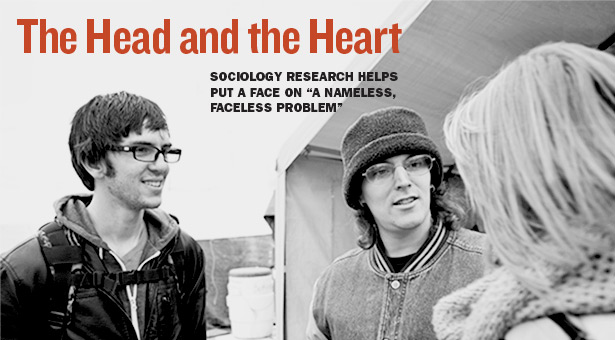 Alex Mikulas ’12 (left) with Tent City 3 residents.
Alex Mikulas ’12 (left) with Tent City 3 residents.
By Hannah Notess (hnotess@spu.edu) | Photo by Luke Rutan
What’s the church doing about homelessness? How can we get Christians to care? When students started asking these questions in Associate Professor of Sociology Karen Snedker’s “Sociology of Homelessness” seminar class, it challenged her thinking. Trained to approach social problems from an objective, scientific perspective, she says that combining her own Christian faith with sociological research was “clearly inspired by my faithful students.”
Now she believes that research can — and should — help make change happen. A paper co-written with Alex Mikulas ’12 includes both ethnographic interviews with and photographs of people experiencing homelessness, arguing that stories and photos are an important way to help solve what Snedker calls the “nameless, faceless problem” of homelessness.
 SPU students Audrey Riddle '13 and Alex Mikulas '12 did ethnographic interviews with Tent City 3 residents, also taking photographs of them.
SPU students Audrey Riddle '13 and Alex Mikulas '12 did ethnographic interviews with Tent City 3 residents, also taking photographs of them.
Tent City 3, an organized encampment of homeless Seattleites hosted by Seattle Pacific University during Winter Quarter 2012, provided Mikulas, Audrey Riddle ’13, and Snedker with the chance to do those interviews. Snedker and Associate Professor of Sociology Jennifer McKinney also saw the Tent City 3 visit as an opportunity for sociological research because it was “a natural experiment.”
“People can self-select and go down and work with Union Gospel Mission or New Horizons,” says McKinney. “But to intervene as a University and bring something like this right here front and center creates this unique moment in time.”
To find out how hosting Tent City would impact the SPU community, they put together a survey that asked students, faculty, staff, and the Queen Anne neighborhood community for their beliefs about homelessness and about encampment. They posed the questions before and after Tent City’s visit.
The survey results were illuminating.
Before the event, 83 percent of respondents agreed with the statement “SPU hosting Tent City 3 is consistent with the mission “engaging the culture, changing the world.” But after the Tent City stay, 91 percent agreed.
Similarly, 92 percent of respondents thought hosting Tent City impacted SPU positively.
Though Snedker and McKinney caution that the survey was not large enough to be fully representative, it does fall in line with a broader principle from sociological research: When people come face-to-face with others of different social groups, stereotypes disappear.
Negative myths perpetuated in the press are unfounded in academic literature,” says Snedker. This is a point she presses with her students in her urban sociology courses. And now that she’s taught the homelessness seminar twice, she plans to teach it again.
“There’s a clear interest and passion by the student body to know more, to be engaged in the topic on a personal and academic level,” she says.
Survey Results
Below is a portion of the survey that sociologists Karen Snedker and Jennifer McKinney designed to help gauge attitudes about homelessness in the SPU community. It asked questions before and after SPU hosted Tent City 3 on its campus during Winter Quarter 2012. Hope Estes ’13 assisted them with data analysis.
In the survey given before Tent City 3 arrived on SPU’s campus:
- 72 percent agreed with the statement “SPU should be hosting Tent City 3.”
- 81 percent agreed with the statement “SPU hosting Tent City 3 is consistent with the gospel message.”
- 83 percent agreed with the statement “SPU hosting Tent City 3 is consistent with the mission “engaging the culture, changing the world.”
- 83 percent gave a positive answer to the question “Do you think Tent City 3 will impact SPU positively?”
In the survey given after Tent City 3 was hosted on SPU’s campus:
- 85 percent agreed with the statement “SPU should have hosted Tent City 3”
- 88 percent agreed with the statement “SPU hosting Tent City 3 is consistent with the gospel message.”
- 91 percent agreed with the statement “SPU hosting Tent City 3 is consistent with the mission “engaging the culture, changing the world.”
- 92 percent gave a positive answer to the question “Do you think Tent City 3 impacted SPU positively?”
- 88 percent answered “yes” to “Do you think SPU should host Tent City again?”
SPU students, faculty members, and staff members made up the majority of survey participants. Of 331 participants in the pre-Tent-City survey, 35 percent were SPU students (33 percent were undergraduates), 21 percent were faculty members, 29 percent were staff members, and 15 percent other (including SPU administrator, alumni, parents, and community residents). Of 329 participants in the post-Tent-City survey, 53 percent were SPU students (47 percent were undergraduates), 13 percent were faculty members, 31 percent were staff members, and 3 percent other.
